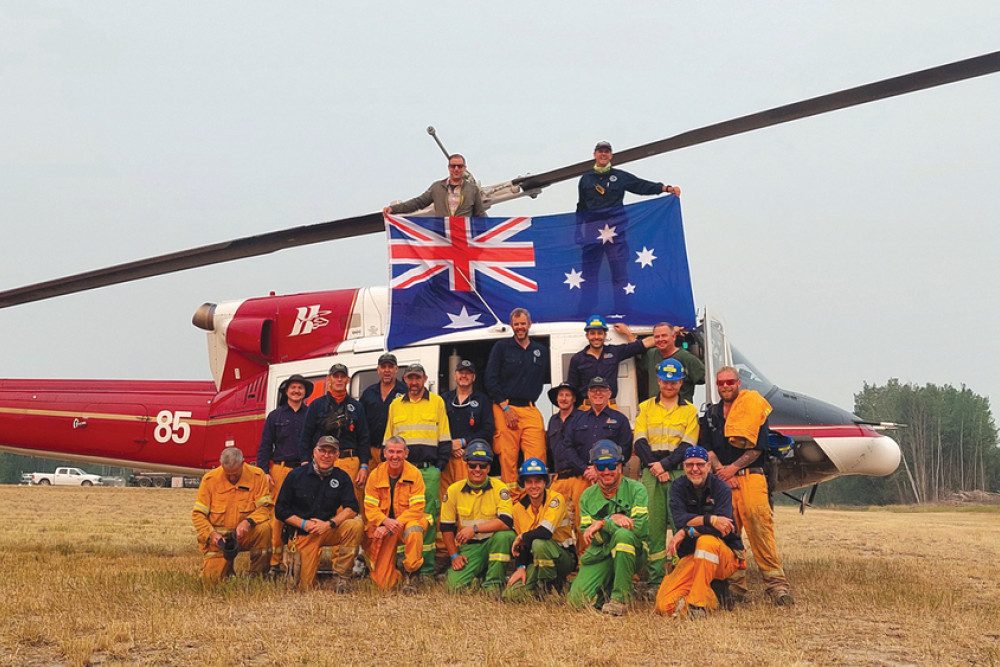Community & Business
9 August, 2023
Mates helping mates
The Commonwealth fraternity lives on through our firefighters, with a contingent of Queensland firies including Steve Benecke from the Cambooya Rural Fire Brigade (RFB) recently travelling to Canada to assist in firefighting.

In the 2019 ‘Black Summer’ bushfires that ravaged Stanthorpe and the Granite Belt region, Canadian firefighters were part of the international effort to control the blazes.
As wildfires in the Canadian province of Alberta began to heat up in June, Queensland Fire and Emergency Services (QFES) and Queensland Parks and Wildlife Service (QPWS)began recruiting volunteers to help.
Steve Benecke, originally from Pittsworth and now residing at Wyreema, has been a volunteer with the Cambooya Rural Fire Brigade for four years.
Mr Benecke jumped at the opportunity, and after passing an arduous pack test demonstrating his fitness, spent most of July in Canada fighting the fire.
The Albertan wildfires have been part of the worst recorded wildfire season in Canadian and North American history.
In total, over 13 million hectares has been burned in the wildfires, ten times the size of the entire Toowoomba Region or close to twice the size of Tasmania.
The fires have affected all 13 provinces and territories of Canada and have cost five lives, including four firefighters.
Mr Benecke said he was tasked to the Whiskey division of the Basset wildfire, which was about 40,000 hectares in size, similar to the fire near Pechey from a few years ago.
Mr Benecke’s crew that was sent to Alberta included 20 from Queensland, comprised of 15 from QFES and 5 from QPWS.
He was the only member from the south-west, with others coming from across the state, including a high concentration from the south-east.
In total, over 70 Queenslanders and over 400 Australians helped fight the Canadian wildfires.
Mr Benecke said while Australia has assisted in overseas firefighting before, this was the first time arduous firefighters have been deployed.
Before Canada, the furthest he had travelled to fight a fire was in the Queensland/New South Wales border area near Stanthorpe.
The difference between an Australian bushfire and a Canadian wildfire is much greater than the name.
Mr Benecke said the key differences are access and terrain.
In Alberta, he was flown in and flown out from his 12-hour workday firefighting duties via helicopter, due to access.
There is also a thick density of spruce and aspen trees, which provide fuel of up to 500 tonnes per hectare.
Mr Benecke was involved in constructing lines to improve access to the fires, backburning and building dozer guards.
He said he was surprised by how resourceful the firefighting services were in Canada.
At the peak, there were 25 helicopters in operation ferrying firefighters in and out of where they needed to be.
Fortunately for Mr Benecke, as a self-employed farmer and earthmover, he was able to take time off work on short notice to help out in Canada.
He said it was a great experience from which he learned a lot.
“The way they fight the fires is different. Lots of hand tools and dealing with not a lot of access due to the swamp conditions,” he said.
“The density of timber makes it that much harder.”
“In the duff layer (the layer of decomposing matter that builds up on a forest floor), the average thickness is a foot - fire creeps along in those conditions.”
A colleague of Mr Benecke said varying fuel types of Spruce, Aspen, Peat and Muskeg total up to 500 tonnes per hectare and intermittent heavy downpours and rain that would extinguish any Queensland fire barely dampen the surface of an Alberta Wildfire.
On the plus side, the abundance of water bodies makes it easier to have enough water to fight fires.
“The water sources there make it easy,” he said.
“The longest hose-lay was 5.6 kilometres. All hoses are manually carried in using quad bikes or side-by-sides.
“It’s a totally different environment.
“If the opportunity came up, I would do it again.”
In addition to Australians, there were firefighters from the United States, New Zealand and South Africa.
In Alberta, there are still close to 90 wildfires actively burning, including some not under control.


